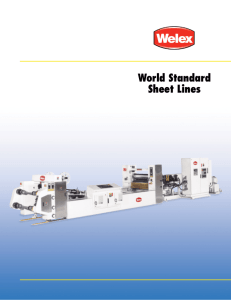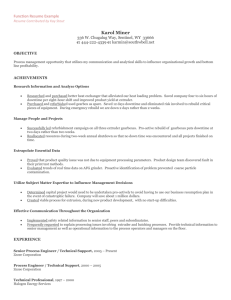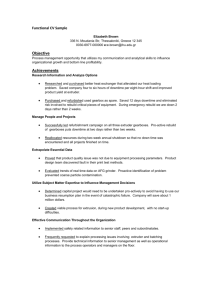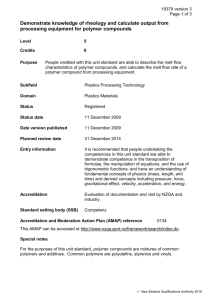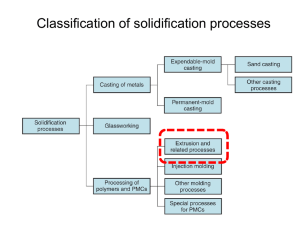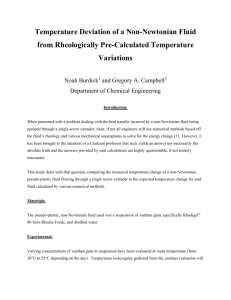Energy Consumption and Efficiency in Single Screw Extrusion
advertisement
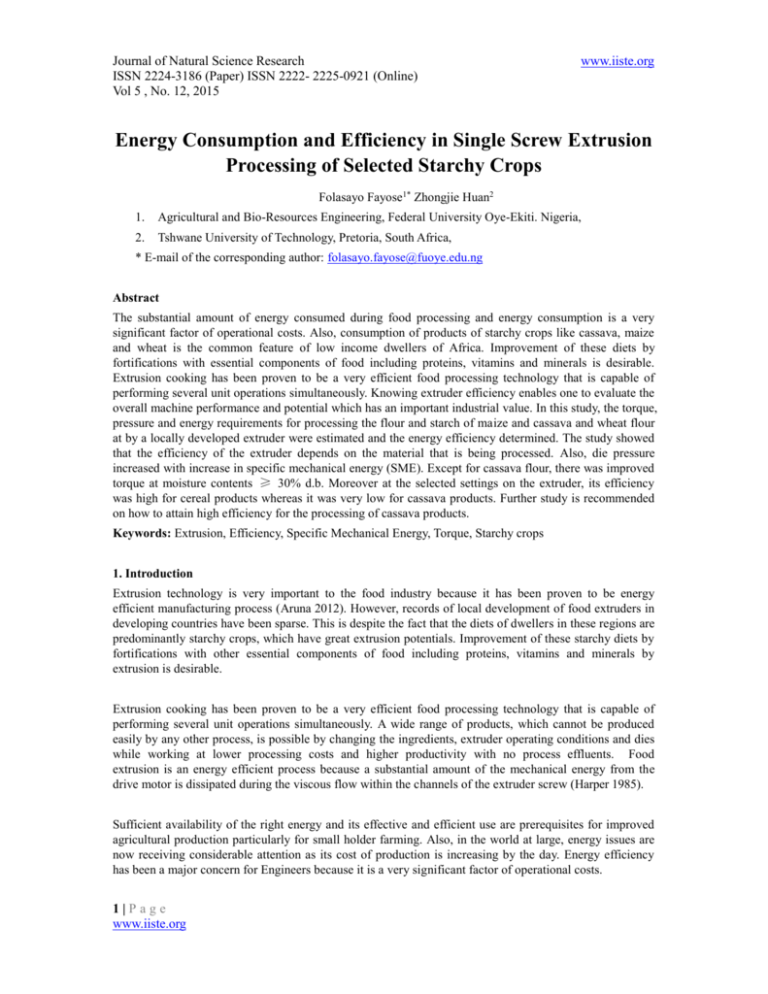
Journal of Natural Science Research ISSN 2224-3186 (Paper) ISSN 2222- 2225-0921 (Online) Vol 5 , No. 12, 2015 www.iiste.org Energy Consumption and Efficiency in Single Screw Extrusion Processing of Selected Starchy Crops Folasayo Fayose1* Zhongjie Huan2 1. Agricultural and Bio-Resources Engineering, Federal University Oye-Ekiti. Nigeria, 2. Tshwane University of Technology, Pretoria, South Africa, * E-mail of the corresponding author: folasayo.fayose@fuoye.edu.ng Abstract The substantial amount of energy consumed during food processing and energy consumption is a very significant factor of operational costs. Also, consumption of products of starchy crops like cassava, maize and wheat is the common feature of low income dwellers of Africa. Improvement of these diets by fortifications with essential components of food including proteins, vitamins and minerals is desirable. Extrusion cooking has been proven to be a very efficient food processing technology that is capable of performing several unit operations simultaneously. Knowing extruder efficiency enables one to evaluate the overall machine performance and potential which has an important industrial value. In this study, the torque, pressure and energy requirements for processing the flour and starch of maize and cassava and wheat flour at by a locally developed extruder were estimated and the energy efficiency determined. The study showed that the efficiency of the extruder depends on the material that is being processed. Also, die pressure increased with increase in specific mechanical energy (SME). Except for cassava flour, there was improved torque at moisture contents ≥ 30% d.b. Moreover at the selected settings on the extruder, its efficiency was high for cereal products whereas it was very low for cassava products. Further study is recommended on how to attain high efficiency for the processing of cassava products. Keywords: Extrusion, Efficiency, Specific Mechanical Energy, Torque, Starchy crops 1. Introduction Extrusion technology is very important to the food industry because it has been proven to be energy efficient manufacturing process (Aruna 2012). However, records of local development of food extruders in developing countries have been sparse. This is despite the fact that the diets of dwellers in these regions are predominantly starchy crops, which have great extrusion potentials. Improvement of these starchy diets by fortifications with other essential components of food including proteins, vitamins and minerals by extrusion is desirable. Extrusion cooking has been proven to be a very efficient food processing technology that is capable of performing several unit operations simultaneously. A wide range of products, which cannot be produced easily by any other process, is possible by changing the ingredients, extruder operating conditions and dies while working at lower processing costs and higher productivity with no process effluents. Food extrusion is an energy efficient process because a substantial amount of the mechanical energy from the drive motor is dissipated during the viscous flow within the channels of the extruder screw (Harper 1985). Sufficient availability of the right energy and its effective and efficient use are prerequisites for improved agricultural production particularly for small holder farming. Also, in the world at large, energy issues are now receiving considerable attention as its cost of production is increasing by the day. Energy efficiency has been a major concern for Engineers because it is a very significant factor of operational costs. 1|Page www.iiste.org Journal of Natural Science Research ISSN 2224-3186 (Paper) ISSN 2222- 2225-0921 (Online) Vol 5 , No. 12, 2015 www.iiste.org According to Liang et al. (2002), energy consumption and extruder efficiency for food extrusion are complex functions of the properties of processed material, design of extruders, type of motor drive and extrusion conditions. Due to the complex relationships of the food, the water, and the extrusion conditions, a number of efficiency measures can be worked out, each appropriate to circumstances and therefore selectable to bring out special features important in the particular process. Energy efficiencies are also meant for providing an objective comparison between different extruders and extrusion processes. Knowing extruder efficiency enables one to evaluate the overall machine performance and potential which has an important industrial value. It is necessary to determine the energy efficiencies in preliminary studies of extruders so as to understand and know the extruder’s profile under any condition and to be able to control it effectively for any particular application. This study, therefore, was undertaken to evaluate the performance of a locally developed extruder with a view to improve on it. 2. Materials and Methods The study was conducted as follows: 2.1 Estimation of Parameters According to Liang et al. (2002), extruder efficiency is considered the theoretical power required divided by the actual power consumed. ᶯ = The extruder efficiency, η, is defined as: 𝑃𝑡ℎ⁄ 𝑃 (1) Where P is the input power and Pth is the theoretical power. The theoretical power required in an extruder, P th, can be expressed as: 𝑃 (2) 𝑄∆𝑝 𝑇 𝑡ℎ =𝑄 ∫𝑇𝑖𝑜 𝐶𝑝𝛿𝑇 + 𝜌 + 𝑄∆𝐻 Where Q is a mass flow, To and T1 are inlet and outlet materials temperature Cp is the specific heat of the polymer, p is discharged pressure, ρ is the specific density of polymer, and H is the enthalpy changes associated with starch gelatinization and protein denaturization per unit weight of extruder. A conversion of Pth to the theoretical unit mass energy consumption, Eth, is given as: 𝐸𝑡ℎ= 𝑃𝑡ℎ ⁄𝑄 (3) The actual total power input, P or energy consumption is the sum of both mechanical (SME) and heat energy (SHE) input. Therefore η is defined as follows: ᶯ= 𝑃𝑡ℎ 𝑃 = 𝐸𝑡ℎ (4) 𝑆𝑀𝐸 +𝑆𝐻𝐸 The SHE for all extrusion condition in this study is zero since heat was generated through viscous dissipation SME (in kJ/kg) was calculated using the following formula by Liang et al. (2002) SME (kJ/kg) = nactual x %T x Prated nrated 100 (5) Fr Where n = screw speed (rpm), T = net torque, define as the measured torque less than the lost frictional torque P = motor power (kW) and Fr = feed rate (kg/s). The measured torque was the total torque required to turn the screw that has two components: torque 2|Page www.iiste.org Journal of Natural Science Research ISSN 2224-3186 (Paper) ISSN 2222- 2225-0921 (Online) Vol 5 , No. 12, 2015 www.iiste.org required to work the product, the net torque, and the torque-required to turn the screw, the no load torque. By running the extruder with water at operating temperatures and screw speeds, the no load torque was measured. The torque T was calculated using the equation below according to Khurmi (2006). 𝑇 = 60𝑃⁄2𝜋𝑁 (6) Where P is the motor power (kW) and N is the rpm of the screw. The no-load torque was subtracted from the operational torque to obtain the corrected torque. The percent torque %T is a ratio of the actual torque and the operational torque expressed as a percentage. The die pressure was estimated using equation 7. 𝑄 = K𝑑 P𝑑 (7) µ Where Q = volumetric flow rate (m3/s), Pd =Total pressure drop (MN/m2, (Pa.s), µ = Dough viscosity at the die Kd= die constant which is a function of geometry Also, die constant for the cylindrical die is given by equation 8 as follows: K𝑑 = 𝜏𝑅 4 (8) 8L𝑑 Where τ = shear stress (N/m2), τ = µ, R = nozzle radius, Ld = length of die, µ = apparent viscosity, γ = shear rate s−1 Apparent viscosity µ was calculated according to Alvarez - Martinez et al. (1988) as follows: 𝜇𝑜 = 78.5 (𝛾)−49 𝑒 ( 2500 ) −7.9𝑀 𝑇 𝑒 𝛾 = 𝜋𝐷𝑁⁄𝐻 (9) (10) Where µ o = dough viscosity at the die (Pa.s), T = Barrel temperatures 0C, M = Moisture fraction of the feed (%), D = Barrel diameter (m), N = Screw speed (rps), H = average screw channel length over the active volume (m). Specific heat (Cp in (kJ-1kg-1K-1) was calculated mathematically as follows: Cp = 1.424mc + 1.549mp + 1.675mf + 0.837ma + 4.187mm (11) Where m is the mass fraction and the subscripts denote carbohydrate, protein, fat, ash and moisture. The phase change ∆H (enthalpy, in kJ-1kg-1) associated with starch gelatinization and protein denaturation was estimated using the following equation (12). ∆H = 14.Xs + 95 Xp 3|Page www.iiste.org (12) Journal of Natural Science Research ISSN 2224-3186 (Paper) ISSN 2222- 2225-0921 (Online) Vol 5 , No. 12, 2015 www.iiste.org Where Xs and Xp are mass fractions of starch and protein respectively. 2.2 Extrusion The extruder used in this study is the dry type and was developed by the author in 2009. It is made up of three (3) main units namely the feeding unit, the compression and melting unit and the die unit all fabricated using locally available materials. The feeding unit and the compression/melting unit are operated by one electric motor through a gear reducer and belt and pulley transmission system. As a test rig, allowance was given for varying the screw configuration, feed rate, screw speed, die configuration and nozzle. Speed variation was done by varying the pulley ratios. All parts through which the feed material will pass were made of stainless steel to prevent food contamination and to withstand frictional wear. Figure 1 shows the isometric drawing of the extruder. The extruder screw is of single flight, increasing diameter and tapering/decreasing pitch with a compression ratio of 4.5:1 L/D Ratio of 12:1. The diameter of the final portion of the screw is reduced to a cone. This aid in pressure built up, easy conveyance of materials through the die and in reducing wear rate. An electric motor drives the screw through a gear reducer, and the backward thrust of the screw is absorbed by a thrust bearing. The rated power of the motor is 4KW wi9oth a rated speed of 2800 rpm. The barrel and the screw/die configuration are typical of alimentary food production equipment. The extrudates were extruded as ribbons to be cut with rotary cutter. Other details about this extruder can be found in Fayose (2009) and Fayose, F.T. et al. (2009). 2.3 Preparation of Samples Samples of flour and starch of cassava (cf and Cs) were sourced and prepared from the same varieties to give room for basis of comparison of results. Cassava tubers (Manihot esculenta Crantz) TMS 30572, were sourced from experimental plots at the Federal College of Agriculture, Akure and processed into flour and starch respectively according to International Starch Institute Standards (2005). The materials were passed through a 300µm sieve separately and the proximate analysis and moisture contents (dry basis) of samples were determined as described by AOAC (1995) approved method. White maize, EV8363-SR QPM (breeder seed) was sourced from the International Institute of Tropical Agriculture (IITA), Ibadan and processed into flour and starch (mf and ms) respectively as described by Akanbi et al (2003) Hard durum wheat flour (Triticum aestirum) (wf) was purchased from the local market. 2.3 Experimentation Procedure Tests samples were fed into the extruder at a feed rate 10Kg/h at room temperature. The extruder was operated for 30 minutes for each set of condition. Temperature, both of the barrel and product were varied by continuous running of the machine, thereby building up the temperature. Duration of operation was measured with a stop watch as the extruder was running by varying the time of sample collection. Since barrel temperature varies with duration of operation, duration of operation was observed as the independent variable. Temperature was controlled by dipping the barrel and screw in a bath of cold water at each run of sample. The density of the extrudates was determined according to Liang et al. (2002) by conducting dead stop extrusion runs of each sample. The extrusion operation was intentionally shut down after reaching steady state. The die plate was opened immediately and very dense, solid chunk pieces of extrudates about 10 to 20 g each were collected from the space between the screw top and die. The dough sample was immediately wrapped using a plastic film, weighed, and submerged for measurement of its volume by water displacement method. Torque and SME were calculated as earlier described in 2.1. Measuring instruments such as probe thermometer, tachometer, stopwatch, analytical balance, measuring cylinders, blenders, were used for immediate measurement of product temperature, actual screw speed, duration of 4|Page www.iiste.org Journal of Natural Science Research ISSN 2224-3186 (Paper) ISSN 2222- 2225-0921 (Online) Vol 5 , No. 12, 2015 www.iiste.org sampling, weights of samples and other parameters under the study. A range of feed moisture from 25 - 45% w.b. was selected for cassava flour, starch and wheat flour while 30 - 50% was selected for maize for further investigation. This was because feed moisture ≤ 20 % blocked rotation of the screw as there was no transition from the original floury nature to a melted state typical of most extrusion processing. 3. Results and Discussion The results are discussed as follows: 3.1 Extrusion Torque The effect of initial moisture content on torque at 30min duration of operation and 100 rpm screw speed for all the products under study is shown in Figure 2. The graph shows that torque decreases with increase in moisture content from 25 to 40%. Maximum torque of 105 Nm per 30 minutes was attained through viscous dissipation at 100 rpm and 25% moisture content while a minimum of 3.35 Nm occurred at 200 rpm and 40% moisture content. The reason for torque decrease with increase in moisture content was because water acts as a plasticizer that decreases viscosity. The problem of the screw getting stuck at lower moisture levels can be overcome by improving the torque. This is by selecting a high speed prime mover and attempt to step down its speed on the extruder by using a bigger pulley. This will improve the propelling force and reduce the tendency for belt slippage. 3.2 Extrusion System Response Parameters The result of the experiments on extrusion system response parameters are presented in Tables 1 and 2. Extrusion system variables (torque, specific mechanical energy, die pressure, and product temperature) are important parameters as well as indicators of extrusion processes. They are the controlled variables in an extruder (Chessari and Sellahewa 2001). For cereal products, the die pressure was within the range of 35006500 KPa while for cassava products, the die pressure was high (≥ 16, 000 KPa). This observation could be because of differences in their viscosities under extrusion. Generally, there was increase in die pressure for all the products probably due to increase in their viscosities. From Table 2, the properties of maize flour were so characterized because at a moisture content of 30 %, the maize was not solvated; hence it has not melted as expected of extruded products. Hence the viscosity, density and other properties were far below those of the other cereals under study. The efficiency for maize flour processing with this extruder can be improved at moisture contents 40% - 50% just like those of other cereals under study. Cereal products are known to exhibit shear thinning under shear. Cassava extrudates however seemed to exhibit shear thickening behaviour under extrusion with increase in viscosity under increased extrusion time. This made them to expand more than cereal products in previous studies [Fayose 2012, Fayose 2009). Die pressure in the range of 17,000 KPa has been reported for highly viscous products as evidenced in this case of cassava products (Fellows (2003). Also, Guy and Horne (1988) in Gonza´lez et al. (2006) observed that increase in SME favoured expansion through an enhanced molecular degradation. Gonza´lez et al. (2006) on the other hand found that softer material gave higher pressure than hard materials. Cassava flour and starch with softer texture than maize will give higher die pressure than maize. Moreover, for cassava products, a rise in viscosity with temperature before a decline was reported by Fayose (2009). This may be due to the fact that it requires greater force to break the strong bonds that exists between the starch molecules than those of cereals because of their higher amyl pectin contents than those of cereals starches (National Starch and Chemical Industry). Also, the gelatinization temperature for cassava is lower than that of maize and wheat (Ihekoronye. and Ngoddy 1985; Van Zuilichem and Stolp 1987), it was easier for cassava to cook/gelatinize under the heat provided by the extruder, hence, a higher solubility and viscosity. Generally for cereal extrusion, expansion decreases with increasing concentration of other materials (Chang and El-Dash 2003). However, a deviation from this behaviour was observed with cassava extruded products. This variation in this result with previous studies may be due to the variety of the cassava (TMS 30572) used. This is because efforts have been on the increase to improve cassava by focussing on increasing yield, dry matter content, nutritional and protein content as a means to contribute to a sustainable and cost effective solution to malnutrition (Dixon 2007). Further studies would however be 5|Page www.iiste.org Journal of Natural Science Research ISSN 2224-3186 (Paper) ISSN 2222- 2225-0921 (Online) Vol 5 , No. 12, 2015 www.iiste.org required to substantiate these observations. 3.3 Extruder’s Efficiency For the evaluation of the extruder’s efficiency, the results of the variables involved as calculated from equations 1 - 11 are presented in Tables 1 and 2. Table 1 shows the calculated Cp and ∆H. From Table 2, the efficiency of the extruder for the various materials processed show that it is more efficient processing cereal products than cassava products. This may be due to the fact that, being a dry type extruder, highly viscous materials typical of cassava products is hard to process through this extruder type.It was also discovered in previous studies on this extruder (Fayose 2009) that extruder efficiency increased with duration of operation for cereal product (maize and wheat) and decreased with duration of operation for cassava products until steady state was attained. According to Sikora (2007), increasing the efficiency of the polymer extrusion process can be attained by the increase of the flow rate of the processed polymer and the decrease of the specific energy consumption. A probable means of improving the efficiency of this extruder for cassava processing is by reducing the torque and hence the specific mechanical energy. This can be achieved by transferring heat from heaters through the barrel walls. With this, torque will be reduced. However, this may mean an additional SHE. Also, an extruder cannot be expected to run at 100% efficiency, since the extruder is not completely adiabatic and the system itself consumes power, plus the external energy consumption. The high efficiency attained with processing of cereals by this extruder may be due to its geometry (L/D-12:1; die length 20mm) when compared to previous studies like Liang et al. (2002) and Kim et al. (1982). 5. Conclusion The torque, energy and pressure requirements for processing the flour and starch of maize and cassava and wheat flour by a locally developed extruder were estimated and the energy efficiency determined. The efficiency of the extruder depends on the material that is being processed. Also, die pressure increased with increase in specific mechanical energy (SME). Except for cassava flour, there was improved torque at moisture contents ≥ 30% d.b. Moreover at the selected settings on the extruder, its efficiency was high for cereal products whereas it was very low for cassava products. Further study is recommended on how to attain high efficiency for the processing of cassava products. The observations from this study will enhance the development and operation of starch screw extruder at minimized production cost and energy consumption. References Akanbi, C. T., Ade-Omowaye, B. I., Ojo, A., and Adeyemi, I. A. (2003), Effect of Processing Factors on Rheological Properties of Ogi. Intl. J. of Food Properties 6(3): 405–418. Alvarez-Martinez, L., Kondury, K. P., and Harper, J. M. A. (1988), General Model for Expansion of Extruded Products. J. of Food Sci., 53: 609–615. AOAC.1995 Official Methods of Analysis of the Association of Official Analytical Chemists, Washington D. C. pp.710. Aruna, K.Y. (2012), Theory of Extrusion Technology, Theory Study Material, Acharya N. G. Ranga Agricultural University, http://www.angrau.ac.in/media. Blanshard J. M. and Mitchell J. R. (1988), Food structure - its creation and evaluation. London: Butter-Worths. pp. 331–349. Chang, Y.K. and El-Dash, A.A. 2003), Effects of acid concentration and extrusion variables on some physical characteristics and energy requirements of cassava starch. Brazilian Journal of Chemical Engineering, 20 (2), 129-137. Chessari, C.J.and Sellahewa, J.N. (2001), Effective Process Control in Guy, R (Ed) Extrusion Cooking Technologies and Applications. Wood head publishing limited and CRC press LLC, Cambridge, England. 2001. 6|Page www.iiste.org Journal of Natural Science Research ISSN 2224-3186 (Paper) ISSN 2222- 2225-0921 (Online) Vol 5 , No. 12, 2015 www.iiste.org Dixon, A.G.O; Ssemakula, G; Maziya- Dixon, B; Caballos, H. and Fregene, M: Genetic Enhancement of protein content in cassava storage roots. Cassava Utilization Programme, IITA. 2007, www.iita.org. Fayose, F.T. (2013), Expansion Characteristics of Selected Starchy Crops during Extrusion, West Indies Journal of Engineering 35: 58-64. Fayose, F.T: The development and performance evaluation of a single screw starch Extruder, P.hD Thesis, Federal University of Technology, Akure, Nigeria. 2009, dspace.futa.edu.ng Fayose, F.T; Ogunlowo, A.S. and Agbetoye, L.A.S. (2009), The Development and Preliminary Testing of an Indigenous Food Extruder. Proceeding of 3rd WASAE Conference, Ile Ife, pp 61. Fellows, P. J. (2003), Food Processing Technology: Principles and Practice. Woodhead Publishers Limited, England. Gonza´lez, R.J; Torres, R.L; De Greef, D. M and Guadalupe, B. A. (2006), Effects of extrusion conditions and structural characteristics on melt viscosity of starchy materials, Journal of Food Engineering 74, 96–107, www.elsevier.com/locate/jfoodeng. Guy, R. C. E and Horne, A. W. (1988), Extrusion and co-extrusion of cereals. In J. M. Blanshard and J. R. Mitchell (Eds.), Food structure - its creation and evaluation. London: Butter-Worths. pp. 331–349. Harper, J.M (1980), Extrusion of Foods, Vol. I. CRC Press Inc, Boca Raton, FL, USA., pp 1- 3 & 77-78. Ihekoronye, A. I. and Ngoddy, P. O. (1985), Integrated Food Science and Technology for the Tropics. Macmillan publishing Co. London. International Starch: Memorandum on Tapioca (Cassava) Starch (2005), International Starch Institute, Science Park Aarhus, Denmark. Khurmi, R.S. (2006), Strength of Materials (Mechanics of Solids) S.I. Units. S. Chand and Company Ltd. New Delhi, pg.765. Liang, M; H.E. Huff, and Hsieh, F. H. (2002), Evaluating Energy Consumption and Efficiency of a Twin – Screw Extruder. J. of Food Sci. 67 (5) 1803-1807. Sikora, J.W. (2007), Review: Increasing the Efficiency of the Extrusion Process Paper presentation at the 2007 International Conference on Parallel Processing (ICPP-07). Published online in Wiley InterScience (www.interscience.wiley.com). VVC 2008 Society of Plastics Engineers DOI 10.1002/pen.20998. Van Zuilichem D.J. and Stolp W. (1987), Survey of the Present Extrusion Cooking Techniques in the Food and Confectionery Industry, In Connor, O.C: Extrusion Technology for the Food Industry, Elsevier Applied Science Publishers, London , pp 1. Folasayo T. Fayose (PhD, Regd. Engr) is a Lecturer at the Federal University Oye-Ekiti in Nigeria. As an agricultural engineer, her interest is in food and agricultural processing machinery, new products development and characterisation. She holds a Ph.D. from the Federal University of Technology, Akure, Nigeria and has served in various capacities in public service and at tertiary institutions. Zhongjie Huan (PhD, Regd. Ingr) is a Professor of Mechanical Engineering at TUT. He holds a PhD degree in Thermal Engineering from Tianjin University, China. He has trained many students at both undergraduate and postgraduate levels, and has consulted in a variety area of energy, refrigeration, air-conditioning and cold storage. 7|Page www.iiste.org Journal of Natural Science Research ISSN 2224-3186 (Paper) ISSN 2222- 2225-0921 (Online) Vol 5 , No. 12, 2015 www.iiste.org A G F B C I H D E LEGEND A- Hopper, B- Feeding Conveyor, C- Extruder worm, D- Die Unit, E- Power train, F- Conveyor pulley, G- Extruder pulley, H- Extruder Housing, I- Control switch Figure 1. The Isometric View of the Extruder Figure 2. Variation of torque with initial moisture content at 100 rpm screw speed. 8|Page www.iiste.org Journal of Natural Science Research ISSN 2224-3186 (Paper) ISSN 2222- 2225-0921 (Online) Vol 5 , No. 12, 2015 www.iiste.org Table 1: Specific heat capacities (Cp) and enthalpy change (∆H) of materials under study cs cf ms mf wf Cp ( kJ-1kg-1K-1 2.254 2.306 2.2541 2.235 2.292 ∆H ( kJ kg ) 9.53 9.53 9.16 9.18 8.72 -1 -1 Table 2: Properties of extrudates at 100 rpm screw speed, 30 % moisture content and 10kg/h feed rate. Torque N SME η (Nm) (rpm) (kJ/kg) (%) 435.76 70 84 42.67 10.21 4264.9 426.5 46 88 29.15 14.63 6500 4045 404.5 4.5 99.5 4.45 90.34 96 3541 2848 284.8 8.0 96 5.53 51.50 120 5500 3330.94 333.09 5.2 99.7 3.95 84.36 Product (oC) Die (kPa) (Kg/m ) temperature pressure cs 1248 123 17495 4357.6 cf 1210 138 16200 ms 1622 148 mf 1012 wf 1421 Density 3 9|Page www.iiste.org Pth Eth
